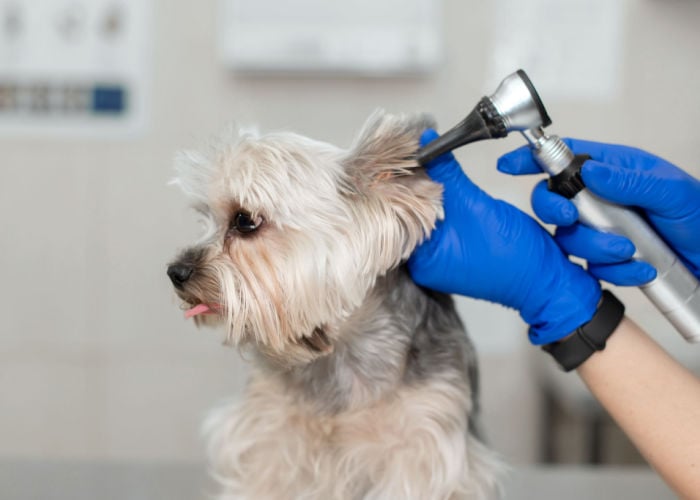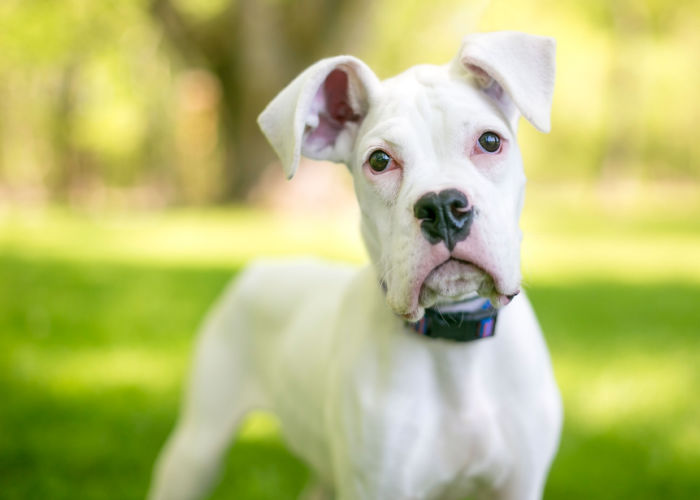Table of Contents
- Deaf Dog Pros and Cons: But Why Do Some Dogs Go Deaf?
- Signs Your Dog is Losing Their Hearing
- Is Owning a Deaf Dog Hard?
- The Pros of Owning a Deaf Dog
- The Cons of Owning a Deaf Dog
- Tips and Tricks to Use When Training a Deaf Dog
- FAQs About the Pros and Cons of Having a Deaf Dog
- Deaf Dog Pros and Cons: Conclusion
Whether you have adopted a new dog that is deaf, or your furry loved one is losing their hearing, there is a lot that may change.
However, regardless of your dog's disability, they are still yours to love, care for, and enjoy.
With that being said, there are indeed pros and cons to owning a deaf dog.
Not everyone has the patience, time, or money to effectively train and take care of a deaf pet.
While this is true, it does not mean that it's impossible either.
First, let's understand more about this condition in canines.
Deaf Dog Pros and Cons: But Why Do Some Dogs Go Deaf?
So, what causes hearing loss?
This is not an easy question to answer since all dogs are vastly different.
Sometimes, hearing loss is a natural part of aging.
About 5-10% of all dogs in the United States are deaf, the majority were born hearing and became impaired as an adult.
Another common reason is trauma. Just as loud noises and trauma can harm our ears, dogs suffer the same.
It's hard to tell when it happens to them though and requires a vet's expert opinion.
Some dogs lose their hearing because of chronic ear infections that permanently scar or harm their eardrums. It typically occurs when the inner ear is infected.
Dog breeds like Basset Hounds, Chinese Shar Peis, and Labradoodles are super prone to ear infections.
They are easy to treat, but when they happen back-to-back, there isn't enough time for your dog's ear to heal and fight against the infection.
Remember though, just because your dog loses their hearing, doesn't mean it's the end of the world! It could be temporary!
Signs Your Dog is Losing Their Hearing
It isn’t likely you will notice immediately when your dog starts to lose hearing. It is gradual, especially if it comes with age.
The following are common signs to watch for that may indicate your dog is losing their hearing.
- Your dog is ‘ignoring’ your commands
- They don’t respond to their name
- They sleep for longer since nothing is there to wake them up
- Loud and frequent barking

Is Owning a Deaf Dog Hard?
I won't lie to you, owning a deaf dog is not for the fainthearted.
Your life sees some adjustments when taking in a deaf dog. However, every dog is different.
There is a danger to owning a deaf dog, but more for themselves than you. Since they are hearing impaired, they can't hear warnings if they are in danger.
Instead, it's up to you as the pet owner to find ways to effectively communicate with them.
Some people use hand motions like sign language, while others focus on vibrations and lights.
Typically, old dogs lose their sign with age and time. They aren't as nervous or affected.
Deaf dogs get used to living without their hearing and come up with their calming methods and management techniques.
Still, it's good to dog-proof your home and make sure it is safe.
The Pros of Owning a Deaf Dog
So, what are the pros of owning a dog?
- They have a stronger sense of smell and sight.
- You can challenge yourself to learn and teach hand signals.
- They don't have noise aversion.
- The noise of fireworks and thunder doesn't wake them up.
- These dogs are excellent cuddlers since they want to feel you near.
- You don't have to tiptoe around them when they are sleeping.
Although there are pros and advantages of taking care of and adopting a deaf dog, you should know that it is a lot of hard work.
You should not take this lightly and instead research the best ways to help them transition to their new home with their disability.
The Cons of Owning a Deaf Dog
Sadly, there are some cons and disadvantages to owning a deaf dog.
However, don't let this discourage you from taking in a loving and adoring pup.
- Harder to train
- Does not understand verbal cues when in danger
- If around other pets, won't hear their warnings to stay away when they are unhappy (especially with cats)
- You can't leave them without a leash in an open area since they can get lost and won't hear your commands.

Tips and Tricks to Use When Training a Deaf Dog
Not everyone will use the same techniques to train their dog. This is especially true if they have a disability.
Deaf dogs require a lot of patience and time.
They won't learn new commands overnight, but it's important to teach them to keep them safe and happy.
Your life isn't over when you adopt a deaf dog, or your dog goes deaf with time.
Instead, it means you have to take a new approach!
Tip #1: Always Begin the Same
Repetition couldn't be any more important.
Dogs need to see and feel the action over and over until it becomes something important to them.
When you start your training sessions and lessons with them, you must use the same command.
You could clap, create a hand signal, or use a visual product with reflective pieces, colors, or lights.
Growing up my neighbor's dog was deaf, and to get their attention and calm them when doing tricks, she would lift her left-hand high. Her dog would immediately sit down.
Tip #2 Change Where You Train Your Dog
I know I just emphasized the importance of consistency, but your dog needs constant exposure to stimuli.
If they only learn in a calming environment, they will only know that same environment.
As we know, public places are colorful, loud, and full of distinct and strong scents.
These senses, apart from hearing, are heightened for a dog.
Tip #3 Bring Treats and Use Them Well
I don't know about you, but I have a hard time saying ‘no' to my dogs.
They are always begging and looking at me with adorable eyes, but treats cannot be used frequently, or their meaning gets lost.
When your dog listens to a new command, regardless of if you use a visual or physical approach, give them a treat.
This could be a new toy or something sweet and scrumptious.
If you give your dog that same treat even when they don't complete the task, they won't understand the treat is a reward for their action.
Tip #4 Come Up with Check-In Symbols
Let's face it, dogs have a mind of their own. They will daze off and get distracted quickly.
It's not enough just to get your dog's undivided attention once during a training session.
Instead, you should come up with symbols or hand signals to get their attention.
I like to use the ‘eyes on me' approach. With two fingers, I point at my eyes over and over until my dog is looking at me.
RELATED: Deaf Dog and Non-Verbal Boy Learned to Speak Through Sign Language

FAQs About the Pros and Cons of Having a Deaf Dog
What are the challenges of a deaf dog?
Owning a deaf dog is not for everyone. Not everything is puppies and rainbows, there are real challenges.
Some challenges include training, getting your dog's attention, and keeping them safe and out of trouble.
Are deaf dogs considered special needs?
Deaf dogs are considered special needs. They have a disability, which is hearing loss.
While it is an invisible need, they still require a lot of support and lifestyle changes.
What do dogs think when deaf?
When a dog loses their hearing slowly because of old age or chronic ear infections, it won’t notice a difference since the losses are subtle and build up.
However, you may notice they stop responding to their name and sleep deeper.
Could a deaf dog hear a dog whistle?
Not all deaf dogs have the same degree of hearing. It is likely your dog may hear dog whistles since they are so low.
However, there is no way of knowing without testing it out or speaking with your dog’s vet to see the damage and cause.
Can you let a deaf dog off the lead?
Experts do not recommend letting a deaf dog off of its leash because it could be extremely dangerous.
If they run into the street, no amount of you calling their name or screaming will get their attention.
Deaf Dog Pros and Cons: Conclusion
Overall, there are pros and cons to caring for a deaf dog, but don’t let the cons scare you! These lovable dogs still need someone in their life.
Even with their invisible disability, they continue to be playful, energetic, exciting, and happy!
With the right training, resources, and tools you can help your dog adjust to life without sound.













